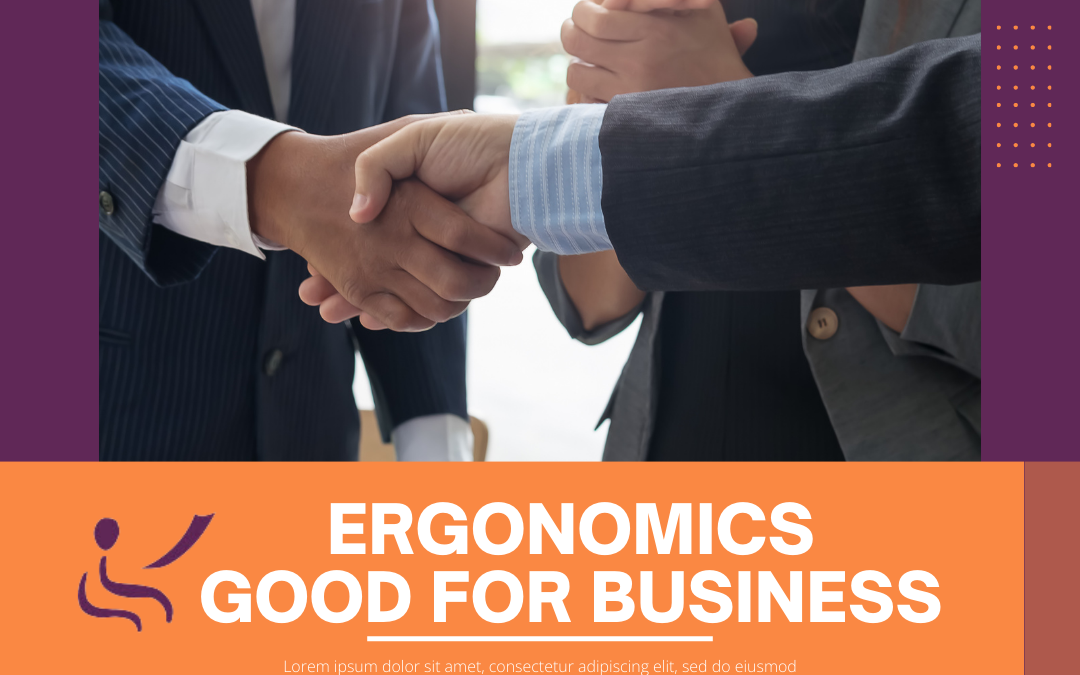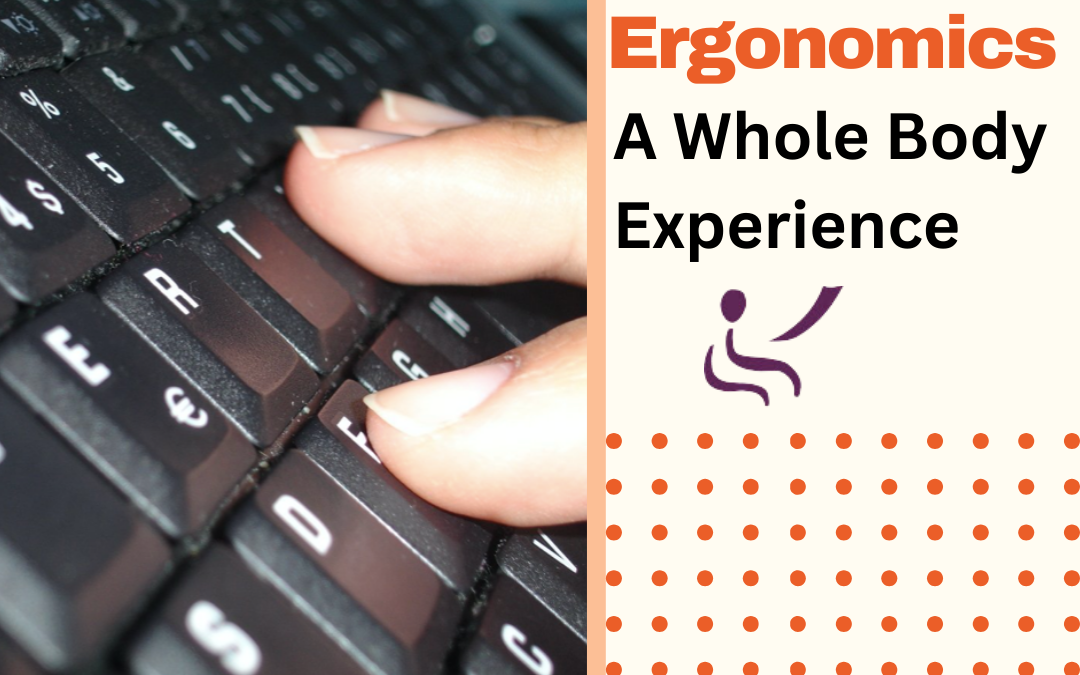
by Serafine Lilien | Nov 3, 2021 | Ergonomics
Health and wellness are vital to you and your staff, ergonomics is vital to health and wellness
• Creating optimal work stations • Teaching healthy body mechanics
• Training stretch routines
The statistics behind Ergonomics (or why you should care):
A compilation of 5 studies showed that implementation of an ergonomics program:
• reduced workplace musculoskeletal disorders 61% on average
• reduced lost workdays by 88% on average
source: Goggins, RW, Spielholz, P, Nothstein, GL (2008). Estimating the effectiveness of ergonomics interventions through case studies: implications for predictive cost-benefit analysis. 39(3): 339-44.
Help prevent the great resignation from happening at your company
Are you interested in retaining your best employees as you boost morale, increase productivity, and reduce your company’s risk and liability?
As a professional ergonomist, these are the results I deliver to my clients!
Discover what a professional ergonomist can do for your organization.
Contact me today for a Free Consult!

by Serafine Lilien | Aug 3, 2021 | ergonomic equipment, Ergonomics
Get a different perspective by having a trained professional look at your work area vs. purchasing a product…..a big picture view. This helps to bring clarity to your whole work area and helps your company save money.
Ergonomics utilizes the science of designing a job environment to fit the worker, instead of expecting the worker to fit the job. Tasks, tools, equipment, and workplace layouts are studied and optimized for a safe and efficient work environment.
When employees consistently use awkward postures or excessive force, they may be at increased risk of developing Repetitive Strain Injuries (RSI). Resulting pain and discomfort can adversely affect productivity and may cause short or long-term problems.
We approach buying services differently than we do purchasing products. It is helpful to ask ourselves: Do I think this product will solve my problems? Do I need training to use this product correctly? Maybe I need help overall? Maybe the product is not the solution? Will a service solve the problem?
People tend to resort to services as a last resort when they cannot do something on their own. How do you feel about services?
Where do Ergonomic Services come into play?
“I don’t need a professional. I can just buy this new keyboard. That will solve my problem.” Will it? How do you know the keyboard is the problem? Maybe it’s because your desk is too high. Maybe the keyboard you have is fine. You do not know. Maybe you are throwing solutions at problem you do not know how to solve because it feels faster than calling in a professional?
A properly designed work environment protects employees from injury and saves company funds in many ways.
Here is an example: If you are creating a new reception area for your organization, it is advisable to make that reception area adjustable. So many reception areas I see are “built in.” Anything that is “built in” is not adjustable in any way, shape or form and can be a poor purchasing decision. Let’s say you install your “built in” table at the reception area at 31” high. You hire a 5’ tall receptionist. She needs to type at 26”, if she is a touch typist, so her “built in” desk is 4” too high for her to work within the ergonomic guidelines for her specific neutral posture. If receptionist works in this awkward position she will be increasing her risk of a musculoskeletal issue at some point in time. So you say, just “build in” at 26” high, well what happens during breaks and the 6’ tall person come by to use that same work station or your receptionist leaves and you hire another one who will have their own specific neutral posture? You got it, it won’t “fit” them.
Ergonomic evaluations provide valuable information to each and every client I see.
See my recent blog titled: ERGONOMICS IS A WHOLE PICTURE EXPERIENCE. IT IS NOT … JUST NEW EQUIPMENT …
In it I talk about what people learn when they have an ergonomic evaluation. Here are the key takeaways:
Ergonomics looks at the whole picture.After looking at the whole picture then we can problem solve.Learning what neutral posture is.Learning to work in that position.I review their entire work area. If you have pain in your hands, how do you know your keyboard is what is causing it?
What an ergonomic assessment includes, is another person viewing what you are doing and HOW you are doing it. You cannot do that for yourself. I know I cannot. By having a trained professional look at your work area you are getting a different perspective. A big picture view. This helps to bring clarity to the whole situation!
If you are uncertain if you or your entire staff need an ergonomic evaluation Ergoarts can, upon your request, send out a discomfort survey to determine priority of issues/concerns allowing for longterm planning and budget friendly options.
If you are planning an office redesign, reach out to Ergoarts prior to ensure you get the best products that are actually usable for your employees.
Make sense? Have questions? Ready for or want more info for an ergonomic evaluation? Contact me, I am here to listen: serafine@ergoarts.net

by Serafine Lilien | Jun 30, 2021 | Ergonomics
Being an ergonomic professional, I meet and experience a wide range of people day to day. I work with a variety of people who have different workplace needs and time schedules.
Ergonomics is the science of fitting the work environment to the employee, (to prevent and resolve injuries). This way employees do not sustain injuries due to an ill-fitting workplace setup. Works stations are usually generic until we create them to fit. Similarly, to how you would want clothes or shoes to fit your body well in order to avoid short term and long term injuries, an ergonomic evaluation will provide you a well-fitting work station.
I am mainly talking about office workers in this article, but I have performed ergonomic assessments in all sorts of environments, from people building airplanes to a cook working in a kitchen. Surprisingly often, ergonomic evaluations start with the person telling me right off the bat: “I just….. need a new…. keyboard/mouse/desk”. This could be before I even tell them what I can offer or what I am planning to do to help them get set up!
These same people will tell me at the very end of the evaluation: “I have learned so much from you. Things I did not know I needed to learn!”
How and why does this happen? The above scenario has occurred to me many, many times.
First, let me explain a little of what I do and what neutral posture is, because it is an important concept and help you to better understand what it is I do.
Neutral posture is a body position that uses the least amount of stress and strains to your muscles, joints, and ligaments. Neutral positions are natural, normal positions that are easy on the body and your musculoskeletal system. These positions are easy for the body to maintain and are painless to reposition from. When your hands and wrists are in an awkward position or non-neutral position, grip strength is actually lost and you have less power to complete the task, plus your muscles work harder and fatigue easier. Performing tasks using awkward posture on a consistent basis can lead to fatigue, discomforts or even disabilities.
We can all learn to use our body in a more neutral position to keep ourselves healthy as well as to reduce or eliminate our discomforts. Using awkward positions “non-neutral” positions can fatigue our arms, hands, limbs, and joints. Maintaining a neutral posture is important because, if you respect the way your body is designed to move while performing your work, then you can minimize aches and pains.
During the ergonomic evaluation I listen to their pain and their solution scenarios. Then, I tell them what I am there to do.
I start with:
1. I will be reviewing your entire set up to find out what is causing the issue (if indeed they have an issue- preventative evaluations are always best) and this is important because helps me to determine where you are not working in a neutral position. I focus on your entire posture to help me determine why you may be hurting.
2. I will teach you about neutral posture
3. I will evaluate your work area to make sure you can work in neutral
4. Your company will often provide whatever product you may need for you to work in neutral
5. I will look at your whole setup and from that perspective, help you solve your physical issues.
At the end of the ergonomic evaluation, maybe they do need a new keyboard and maybe that will solve their problem. Or maybe their current keyboard is fine and really the height of the keyboard, either too high or too low, was the issue.
If they do need a new keyboard, then I will teach them how to use it within a neutral range so they do not continue to work in an awkward position.
It is not until I watch them work, see what postures they are currently using, and teach them how to work in neutral, that am I able to help them solve their physical issues.
Many, many times at the end of the evaluation people say to me: I have learned so much from this appointment. Thank you so much for all the valuable information you shared with me. I had no idea ergonomics was all this.
Yes, ergonomics is a whole picture experience. If you change one thing, something else will change, because our bodies are connected. With ergonomics, we need to look at the whole picture before we can offer you solutions.
For more information or to schedule an ergonomic evaluation please email me.

by Serafine Lilien | Feb 3, 2020 | Ergo Tips, Ergonomics
A study of 7,300 workers finds those who primarily stood were twice as likely as those who primarily sat to suffer from heart disease during a 12-year period.
Sandy Smith | Aug 18, 2017
“A combination of sitting, standing and moving on the job is likely to have the greatest benefits for heart health,” says Smith. “Workplaces need to apply this message not just to workers who predominantly sit, but also – in fact, especially – to workers who predominantly stand.”
“Prevention programs that focus solely on physical job activity, while ignoring other conditions such as the psychosocial work environment, are unlikely to lead to meaningful changes in cardiovascular risk,”
Smith says.
Here is a link to the study: https://academic.oup.com/aje/article/187/1/27/4081581
The Relationship Between Occupational Standing and Sitting and Incident Heart Disease Over a 12-Year Period in Ontario, Canada. Peter Smith, Huiting Ma, Richard H Glazier, Mahée Gilbert-Ouimet, Cameron Mustard. American Journal of Epidemiology, Volume 187, Issue 1, January 2018, Pages 27–33,https://doi.org/10.1093/aje/kwx298. Published: 11 August 2017
Here is the link to EHS article referring to the study: https://www.ehstoday.com/health/prolonged-standing-job-greater-risk-heart-disease

by Serafine Lilien | Jan 27, 2020 | Ergo Tips
Keep all screens clean and avoid working while
there is glare on the screen
Here is a quick check.
Turn off your computer.Do you see any reflections left on the screen?Did you see the window behind you or the bright ceiling light?
If so, your computer is causing glare.Turn the screen away from those reflections.
Remember to take eye-rest breaks even when set up optimally.
Use the 20-20-20 Rule.
Every 20 minutes,
look at something 20 feet away
for 20 seconds.
There is a little video that shows you how to do it and the picture above shows you the points you will need to press with your fingers:
https://www.youtube.com/watch?time_continue=27&v=qD2OaU8FdFE
For More Ergonomic Solutions feel free to contact me!!





